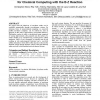Free Online Productivity Tools
i2Speak
i2Symbol
i2OCR
iTex2Img
iWeb2Print
iWeb2Shot
i2Type
iPdf2Split
iPdf2Merge
i2Bopomofo
i2Arabic
i2Style
i2Image
i2PDF
iLatex2Rtf
Sci2ools
106
click to vote
GECCO
2007
Springer
2007
Springer
Towards the coevolution of cellular automata controllers for chemical computing with the B-Z reaction
We propose that the behaviour of non-linear media can be controlled automatically through coevolutionary systems. By extension, forms of unconventional computing, i.e., massively parallel non-linear computers, can be realised by such an approach. In this study a light-sensitive sub-excitable BelousovZhabotinsky reaction in which a checkerboard image comprised of varying light intensity cells projected onto the surface of a catalyst loaded gel is controlled using a heterogeneous cellular automaton. Pulses of wave fragments are injected onto the gel resulting in rich spatio-temporal behaviour and a coevolved cellular automaton is shown able to either increase or decrease the chemical activity through dynamic control of the light intensity within each cell in both simulated and real chemical systems. Categories and Subject Descriptors I.2.8 [Artificial Intelligence]: Problem Solving, Control Methods and Search – backtracking, control theory, dynamic programming, graph and tree search s...
| Added | 07 Jun 2010 |
| Updated | 07 Jun 2010 |
| Type | Conference |
| Year | 2007 |
| Where | GECCO |
| Authors | Christopher Stone, Rita Toth, Andrew Adamatzky, Ben de Lacy Costello, Larry Bull |
Comments (0)

